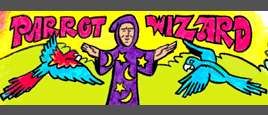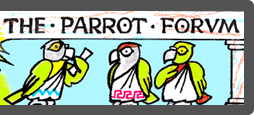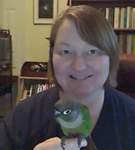I am working some on simple tricks and things with Scooter. Basically just for fun and so we have some variety in our interactions. I haven't really found anything in the way of a hand-held food treat that he is excited about. He's a very good eater in general and eats a wide variety of fresh food, but when he's out he doesn't seem all that interested (unless he's watching me cut up stuff, then he wants some, too). I could reserve millet spray for this use, he does like that, but what a mess! I didn't realize "spray" was a pun before Scooter. But I digress...
I have made some headway just by making a positive fuss when he does the right thing and maybe scratching his head. The word "good" become both the bridge and part of the reward. Can this be an adequately strong reward for training a parrot? I know people pat their horses when they do well, but IMO it's really not a very strong reward for a horse. I've also done clicker training with horses and their response to a food reward is SO strong you have to be really careful to train them not to mug you for the treats. Is this also true with most parrots? What do you use for your reward and what do you use for your bridge?
While I have made some progress, I feel that my rewarding is not as crisp and precise as it might be, and while we are both having fun, which is the main point, I could perhaps be doing more effective training.



Effective Rewards to Use for Bridge Conditioning
5 posts • Page 1 of 1
Effective Rewards to Use for Bridge Conditioning
Scooter 
Death Valley Scotty
Death Valley Scotty
-

entrancedbymyGCC - Cockatoo
- Gender:

- Posts: 2106
- Location: Southern California aka LALA land
- Number of Birds Owned: 2
- Types of Birds Owned: Green Cheek Conure
(Un)Cape Parrot - Flight: No
Re: Effective Rewards to Use for Bridge Conditioning
You have to contrast the difference between primary and secondary reinforcers. First off, saying "good" without a food reward associated with it is damn near worthless to a parrot. It neither knows the meaning of the word nor does it lead to anything good. Imagine your boss telling you "blagabaha." It would be pure gibberish and mean nothing to you and wouldn't even be a money bonus. That simply leads to extinction of behavior as it is not positive reinforcement.
In order to develop a secondary reinforcer, a primary reinforcer has to stand behind it. Food is clearly a positive reinforcer. The other social reinforcements we can try to use are very iffy. Certain types of attention or petting could be primary reinforcers but ONLY if your parrot actually wants them. If the parrot doesn't enjoy petting or doesn't want petting at that time, it could backfire on you and act as a punishment instead.
I was talking to a professor of psychology yesterday and discussing primary vs. secondary reinforcers. I asked if it is ever possible for a conditioned secondary reinforcer to become so strong that it acts as a primary reinforcer with resistance to extinction. He said no. If it is a secondary reinforcer, unless there is an associated primary reinforcer with it, will lose its power as a reinforcer. Basically clicking a clicker and never giving treats would be useless. However, the longer a secondary reinforcer has been employed and the lower the frequency of reinforcement, the more resistant it is to extinction. This means you can give a primary reinforcer in conjunction with the secondary less often.
In order to develop a secondary reinforcer, a primary reinforcer has to stand behind it. Food is clearly a positive reinforcer. The other social reinforcements we can try to use are very iffy. Certain types of attention or petting could be primary reinforcers but ONLY if your parrot actually wants them. If the parrot doesn't enjoy petting or doesn't want petting at that time, it could backfire on you and act as a punishment instead.
I was talking to a professor of psychology yesterday and discussing primary vs. secondary reinforcers. I asked if it is ever possible for a conditioned secondary reinforcer to become so strong that it acts as a primary reinforcer with resistance to extinction. He said no. If it is a secondary reinforcer, unless there is an associated primary reinforcer with it, will lose its power as a reinforcer. Basically clicking a clicker and never giving treats would be useless. However, the longer a secondary reinforcer has been employed and the lower the frequency of reinforcement, the more resistant it is to extinction. This means you can give a primary reinforcer in conjunction with the secondary less often.
-

Michael - Macaw
- Gender:

- Posts: 6286
- Location: New York
- Number of Birds Owned: 3
- Types of Birds Owned: Senegal Parrot, Cape Parrot, Green-Winged Macaw
- Flight: Yes
Re: Effective Rewards to Use for Bridge Conditioning
But making a fuss and giving attention when a bird screams can act as a reinforcer for screaming.... why can't making a fuss and giving attention also act as a reinforcer when training? If the word has no inflection, I agree it is meaningless, but unlike horses and cats, my parrot does seem to feel rewarded when I "make a big fuss". Dogs used to be trained that way as well. I understand it can't be as strong a reinforcement, but there is more going on than Charlie Brown's teacher's voice. I think.
Scooter 
Death Valley Scotty
Death Valley Scotty
-

entrancedbymyGCC - Cockatoo
- Gender:

- Posts: 2106
- Location: Southern California aka LALA land
- Number of Birds Owned: 2
- Types of Birds Owned: Green Cheek Conure
(Un)Cape Parrot - Flight: No
Re: Effective Rewards to Use for Bridge Conditioning
I've worked on and off with Alex for over 2 years with only excitment as a reword for him doing what I want. I get very excited and do a loud Woo-Hoo when he does what I want. Until recently he had NO food that he would do anything for. So rewording with food was out. When I was working pretty regular I had him at 6 colors along with a few minor tricks that went with doing colors sometimes. And once I finally got him to be on his back in my hand. My daughters partner tought him to shake and I re-inforce it with the Woo- Hoo if he does it on cue. If he does it just because he wants to I shake and say Hello then good bird. He now uses Woo-Hoo when he gets what he wants. So he knows what this word/soud is and uses it himself in context. Even though I recently started with the clicker and finally got some hemp seeds to try (which he loves) he still gets his excited Woo-Hoo as well. So to say that only a food reword will allow you to trick train your bird is not true. I wouldn't go with the good as we use it for so much else.
My daughters gcc's also have NO food that they will do anything for. So they also work with the excitment reword. Works just as well for her gcc's as it does for my grey.
My daughters gcc's also have NO food that they will do anything for. So they also work with the excitment reword. Works just as well for her gcc's as it does for my grey.
Alex - cag
Martini - senegal
Martini - senegal
-

Suzzique - Conure
- Gender:

- Posts: 137
- Location: San Diego
- Number of Birds Owned: 2
- Types of Birds Owned: CAG, Senegal
- Flight: Yes
Re: Effective Rewards to Use for Bridge Conditioning
entrancedbymyGCC wrote:But making a fuss and giving attention when a bird screams can act as a reinforcer for screaming.... why can't making a fuss and giving attention also act as a reinforcer when training?
I think it has to do with the strength of the reinforcer. First of all, we must consider how much the bird likes you. Giving it attention for screaming if it hates you could actually be punishment and teach it to be quiet if it doesn't want someone it doesn't like from coming.
Now assuming the bird likes you (especially if it's bonded to you and you're the favorite person) or if the bird is good with people, it may just be bored and having ANY activity be better than none. You see, similar to using weight management and depriving the parrot from food, the cage deprives social interaction. By that logic, giving attention gains value merely from the fact that it was taken away. However, if you have the bird out and spending time with it and want to reinforce a behavior it will be much more ineffective because the bird gets to be with you anyway and gets your attention anyway without doing the behavior.
The being said, I have used some of these social reinforcers on certain behaviors.
1) I encouraged Kili to say "hello" rather than scream to get my attention from the cage. When she screams I don't come. When she says hello, I come right over. Once again, here you can see that the parrot is void of something (attention) and doing the behavior brings the positive reinforcement. This scenario wouldn't work when she is out because she'd already have the attention and the opportunity to be out which are both reinforcing.
2) Shoulder time. I stopped letting Kili fly onto my shoulder herself (deprivation) and will only put her on my shoulder if she flies a recall to my hand first (positive reinforcement). Thus when I have a feeling she wants to be on my shoulder, I recall her and put her there.
As you can see from my examples (and the training discussions about food based reinforcement), there must be an absence of something desired or a deprivation if it is normally present in order to make it reinforcing. Look, if you could have a pair of flighted parrots roaming the house with lots of food available and everything they want, they'd probably never so much as look your way. By manipulating the environment and ensuring that you are the only one that can provide something they desire, you can turn it into positive reinforcement for behavior. This is why I limit my parrot's food, leave her in the cage for periods of time, and don't let her on my shoulder. This way each of these things become desired for the time that she is out and with me. Otherwise she wouldn't listen to me or do anything that has to do with me at all.
-

Michael - Macaw
- Gender:

- Posts: 6286
- Location: New York
- Number of Birds Owned: 3
- Types of Birds Owned: Senegal Parrot, Cape Parrot, Green-Winged Macaw
- Flight: Yes
5 posts • Page 1 of 1
Return to Taming & Basic Training
Who is online
Users browsing this forum: No registered users and 21 guests

